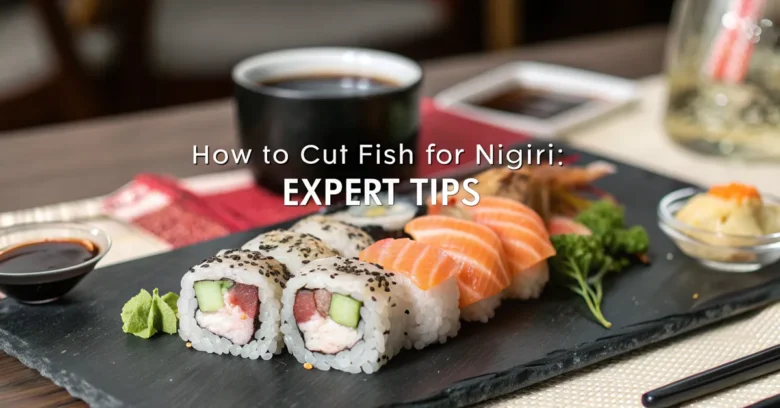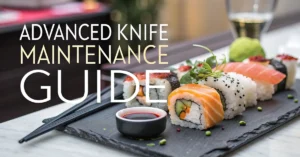So, you’re ready to craft some nigiri like a pro. That sleek slice of fish, draped just so over perfectly seasoned rice – it’s a tiny work of art. But before you can impress anyone (including yourself), you’ve got to master the art of cutting fish. More than 65% of chefs agree that how you cut the fish will determine the taste. This guide will get you there.
How to Cut Fish for Nigiri: Expert Tips
The Right Tools for the Job
Before you even think about touching a fish, you need the right tools. These aren’t just suggestions; they’re crucial for a clean, safe, and delicious result.
- A Sharp Knife: This is non-negotiable. A dull knife will tear the fish, leaving ragged edges and bruising the delicate flesh. Look for a Japanese-style sushi knife like a Yanagiba or Sujihiki. These knives are designed for slicing fish with long, smooth strokes. The sharper the knife, the cleaner the cut. And cleanliness is everything. In sushi, more than in most things, sharpness is next to godliness.
- A Cutting Board: Opt for a non-slip cutting board. Stability is key when you’re working with a sharp knife and slippery fish. Wood or high-density polyethylene (HDPE) boards are good choices. Make sure it’s large enough to accommodate the entire fillet you’re working with. It may be a good idea to clean the cutting board with food-grade sanitizer for the best result.
- A Damp Cloth: Keep a damp cloth nearby to wipe your knife blade between slices. This prevents the fish from sticking and ensures a clean cut every time.
- Fish Scale Remover: If you are cutting a whole fish, the fish scale remover is an extremely important thing to have. It can help with scaling process.
Choosing Your Fish: Freshness is Paramount
The quality of your nigiri depends heavily on the freshness of the fish. Here’s what to look for:
- Appearance: The fish should look vibrant and have a natural sheen. Avoid fish that looks dull, discolored, or slimy.
- Smell: Fresh fish should have a mild, sea-like aroma. Any strong or fishy odor is a red flag.
- Texture: The flesh should be firm and spring back when lightly pressed. If it feels soft or mushy, it’s past its prime.
- Eyes: If you’re buying whole fish, the eyes should be clear and bright, not cloudy or sunken.
- Source: Buy your fish from a reputable fishmonger or supplier. Ask about the fish’s origin and how long it’s been since it was caught. According to the FDA, proper handling and storage are also important.
- Sustainability: Whenever possible, choose sustainably sourced fish to support responsible fishing practices. Look for certifications like the Marine Stewardship Council (MSC) label.
Preparing the Fish: A Clean Slate
Proper preparation is key to both food safety and achieving those perfect nigiri slices.
- Rinse the Fish: Gently rinse the fish under cold running water. This removes any surface debris or scales.
- Pat it Dry: Use paper towels to thoroughly pat the fish dry. Excess moisture can make the fish slippery and difficult to cut.
- Remove the Skin (If Necessary): Some fish, like salmon, are often served skinless for nigiri. To remove the skin, place the fillet skin-side down on the cutting board. Hold the tail end of the skin firmly and, using a long, flexible knife, gently slide the blade between the skin and the flesh, angling the knife slightly downward. Use a sawing motion, keeping the blade as close to the skin as possible to avoid wasting any fish.
- Remove Pin Bones: Run your fingers along the surface of the fillet to feel for any small pin bones. Use tweezers or needle-nose pliers to carefully remove them. Pull them out in the direction they are pointing to avoid tearing the flesh.
Mastering the Cut: Techniques for Different Fish
Different types of fish require slightly different cutting techniques to achieve the ideal texture and presentation. Here are some common examples:
Salmon
Salmon is a popular choice for nigiri, known for its rich flavor and buttery texture.
- Remove the Belly: The belly of the salmon fillet is often fattier and less uniform in shape. You may prefer to remove the belly, cut it into strips, and eat it as sashimi, but most do not use it for nigiri.
- Slice Against the Grain: Identify the grain of the salmon, which runs lengthwise along the fillet. Using a sharp knife, slice the salmon at a slight angle against the grain. This will shorten the muscle fibers, making the fish more tender.
- Thickness Matters: Aim for slices that are about ¼ inch thick and 2 inches long. The exact size will depend on the size of your nigiri rice.
- The Drape: When placing the salmon on the rice, gently curve the slice to create a beautiful drape that covers most of the rice ball.
Tuna
Tuna, with its firm texture and clean flavor, is another classic nigiri choice.
- Remove the Bloodline: Tuna often has a dark red bloodline running through the center of the fillet. This can have a strong, metallic taste. Remove it by slicing it away with a sharp knife.
- Cut into Blocks: Cut the tuna fillet into rectangular blocks. This will make it easier to slice uniform pieces.
- Consistent Slices: Slice the tuna into rectangular pieces that are about ¼ inch thick and 2 inches long.
- Straight Lines: Place the tuna on the rice, making sure that each piece is straight.
Mackerel (Saba)
Mackerel has a stronger flavor than salmon or tuna, and its preparation often involves curing or pickling.
- Skin On or Off?: Mackerel can be served with the skin on or off. If leaving the skin on, make sure it’s properly scaled.
- Thin Slices: Because of its strong flavor, mackerel is best served in thinner slices than salmon or tuna. Aim for slices that are about 1/8 inch thick.
- Diagonal Cut: Cut the mackerel at a sharp diagonal to accentuate its visual appeal.
- Ginger Accent: A small sliver of ginger is often placed between the mackerel and the rice to complement the fish’s flavor.
Shrimp (Ebi)
Unlike other nigiri, shrimp is usually cooked before being served.
- Butterfly Cut: To prepare the shrimp, make a shallow cut along the back, almost all the way through.
- Open Flat: Gently open the shrimp so it lies flat, resembling a butterfly.
- Boil: Boil the shrimp until cooked thoroughly.
- Place Over Rice: Place the shrimp over the rice.
Squid (Ika)
Squid offers a unique chewy texture and mild flavor.
- Score the Surface: Lightly score the surface of the squid with a crosshatch pattern. This makes it more tender and visually appealing.
- Slice into Strips: Cut the squid into thin, even strips.
- Place Over Rice: Place the squid over the rice.
Tips for a Perfect Slice
- Keep the Fish Cold: Work with the fish straight from the refrigerator. Cold fish is easier to slice cleanly.
- Use Long, Smooth Strokes: Avoid sawing or hacking at the fish. Use long, smooth strokes with your knife to create a clean cut.
- Maintain a Consistent Angle: Keep the angle of your knife consistent throughout the cut to ensure uniform thickness.
- Practice Makes Perfect: Don’t get discouraged if your first few attempts aren’t perfect. The more you practice, the better you’ll become at cutting fish for nigiri.
Safety First: Preventing Cross-Contamination
Working with raw fish requires strict attention to food safety to prevent cross-contamination.
- Dedicated Cutting Board: Use a dedicated cutting board solely for raw fish. This prevents the spread of bacteria to other foods.
- Sanitize Your Tools: Thoroughly wash and sanitize your knife, cutting board, and any other tools that come into contact with raw fish after each use.
- Wash Your Hands: Wash your hands thoroughly with soap and water before and after handling raw fish.
- Temperature Control: Keep the fish refrigerated at all times, except when you’re actively cutting it.
Beyond the Slice: Other Presentation Tips
The way you present your nigiri is just as important as the taste.
- Rice Perfection: The rice should be perfectly cooked, seasoned, and shaped. Use sushi rice, and follow a proper seasoning ratio.
- Wasabi Touch: A small dab of wasabi between the fish and the rice adds a subtle kick and helps to bind the fish to the rice.
- Garnish Wisely: Simple garnishes like a sprig of parsley, a sprinkle of sesame seeds, or a thin slice of lemon can enhance the visual appeal.
Common Mistakes and How to Avoid Them
Even experienced sushi chefs can make mistakes. Here are some common pitfalls and how to avoid them:
- Dull Knife: A dull knife is the enemy of clean cuts. Sharpen your knife regularly or invest in a high-quality knife sharpener.
- Tearing the Fish: This is often caused by a dull knife or using too much pressure. Let the sharpness of the knife do the work, and use smooth, controlled strokes.
- Uneven Slices: This can be due to inconsistent knife angles or pressure. Focus on maintaining a consistent angle and pressure throughout the cut.
- Overhandling the Fish: Excessive handling can warm the fish and make it mushy. Work quickly and efficiently.
- Ignoring the Grain: Cutting with the grain results in tough, stringy slices. Always cut against the grain to shorten the muscle fibers.
Elevate Your Nigiri: Experimentation and Creativity
Once you’ve mastered the basics, don’t be afraid to experiment with different types of fish, cutting techniques, and presentations. Try different garnishes, sauces, or even infused rice to create your own signature nigiri.
- Different Fish Varieties: Don’t limit yourself to just salmon and tuna. Try other types of fish like yellowtail (hamachi), sea bream (tai), or eel (unagi).
- Cutting Styles: Experiment with different cutting styles, such as the “hira-zukuri” (straight cut) or “sogi-giri” (diagonal cut).
- Sauce Accents: A light brush of soy sauce, ponzu sauce, or a homemade glaze can add a burst of flavor.
- Infused Rice: Try infusing the rice with flavors like yuzu zest, ginger, or even a hint of truffle oil.
Nigiri Nirvana: The Art of Presentation
Nigiri is more than just food; it’s an experience. The way you present it is crucial.
- Placement Matters: Arrange the nigiri artfully on a plate, paying attention to color and texture.
- Group in Odd Numbers: An odd number of pieces (3, 5, or 7) is generally more visually appealing than an even number.
- Consider Height: Varying the height of the nigiri pieces can create a more dynamic presentation.
- Contrast Colors: Arrange different types of nigiri to create a visually appealing contrast of colors.
- Negative Space: Don’t overcrowd the plate. Leave some negative space to allow each piece to stand out.
From Novice to Nigiri Ninja: Practice, Patience, and Passion
Cutting fish for nigiri is a skill that takes time, practice, and patience to master. But with dedication and attention to detail, you can create beautiful and delicious nigiri that will impress your friends, family, and even yourself.
So, grab your sharpest knife, choose the freshest fish, and get ready to embark on a culinary journey. Your taste buds (and your guests) will thank you.



